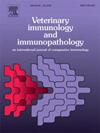自由放养非洲象支气管肺泡灌洗液制备单核细胞分离及细胞学评价的优化
IF 1.4
3区 农林科学
Q4 IMMUNOLOGY
引用次数: 0
摘要
了解对传染病(如结核病)的免疫反应对于开发诊断测试和研究疾病进展至关重要。尽管结核病影响非洲草原象(Loxodonta africana),但很少有研究调查该物种的免疫细胞和功能,特别是呼吸道的免疫细胞和功能。从大象支气管肺泡灌洗液(BAL)样本中分离免疫细胞的技术以前没有报道。因此,本研究旨在开发和优化一种方案,以分离和表征从自由放养的非洲稀树草原象收集的BAL液中的肺泡细胞类型。优化的方案包括粘蛋白消化步骤,过滤,菲科尔梯度分离和洗涤步骤,以去除污染物,并成功分离肺泡单核细胞的活菌群。将分离的细胞用Rapi-Diff染色,并在显微镜下观察每种细胞类型的分化和特征。用这种方法从健康非洲象BAL样本中分离的细胞主要是肺泡巨噬细胞(92.5 ~ 100.0 %),其次是淋巴细胞(0.0 ~ 6.0 %)、中性粒细胞(0.0 ~ 3.0 %)和嗜酸性粒细胞(0.0 ~ 1.0 %)。这项研究为肺泡单核细胞的分离提供了第一个优化的方案,用于未来对呼吸系统疾病(如结核病)局部免疫反应的研究。本文章由计算机程序翻译,如有差异,请以英文原文为准。
Optimisation of bronchoalveolar lavage fluid preparation for mononuclear cell isolation and cytologic evaluation in free-ranging African elephants (Loxodonta africana)
Understanding immune responses to infectious diseases, such as tuberculosis (TB), is essential for developing diagnostic tests and studying disease progression. Although TB affects African savanna elephants (Loxodonta africana), few studies have investigated immune cells and function in this species, especially in the respiratory tract. Techniques for isolating immune cells from elephant bronchoalveolar lavage (BAL) samples have not been previously reported. Therefore, this study aimed to develop and optimise a protocol to isolate and characterise alveolar cell types in BAL fluid collected from free-ranging, African savanna elephants. The optimised protocol incorporated a mucin digestion step, filtration, Ficoll gradient separation and wash steps to remove contaminants and successfully isolate viable populations of alveolar mononuclear cells. The isolated cells were stained with Rapi-Diff and microscopically examined to differentiate and characterise each cell type present. Cells isolated from healthy African elephant BAL samples, using this method, were predominantly alveolar macrophages (92.5 – 100.0 %) followed by lymphocytes (0.0 – 6.0 %), neutrophils (0.0 – 3.0 %) and eosinophils (0.0 – 1.0 %). This study provides the first optimised protocol for the isolation of alveolar mononuclear cells for future investigations into local immune responses to respiratory diseases such as tuberculosis.
求助全文
通过发布文献求助,成功后即可免费获取论文全文。
去求助
来源期刊
CiteScore
3.40
自引率
5.60%
发文量
79
审稿时长
70 days
期刊介绍:
The journal reports basic, comparative and clinical immunology as they pertain to the animal species designated here: livestock, poultry, and fish species that are major food animals and companion animals such as cats, dogs, horses and camels, and wildlife species that act as reservoirs for food, companion or human infectious diseases, or as models for human disease.
Rodent models of infectious diseases that are of importance in the animal species indicated above,when the disease requires a level of containment that is not readily available for larger animal experimentation (ABSL3), will be considered. Papers on rabbits, lizards, guinea pigs, badgers, armadillos, elephants, antelope, and buffalo will be reviewed if the research advances our fundamental understanding of immunology, or if they act as a reservoir of infectious disease for the primary animal species designated above, or for humans. Manuscripts employing other species will be reviewed if justified as fitting into the categories above.
The following topics are appropriate: biology of cells and mechanisms of the immune system, immunochemistry, immunodeficiencies, immunodiagnosis, immunogenetics, immunopathology, immunology of infectious disease and tumors, immunoprophylaxis including vaccine development and delivery, immunological aspects of pregnancy including passive immunity, autoimmuity, neuroimmunology, and transplanatation immunology. Manuscripts that describe new genes and development of tools such as monoclonal antibodies are also of interest when part of a larger biological study. Studies employing extracts or constituents (plant extracts, feed additives or microbiome) must be sufficiently defined to be reproduced in other laboratories and also provide evidence for possible mechanisms and not simply show an effect on the immune system.

 求助内容:
求助内容: 应助结果提醒方式:
应助结果提醒方式:


